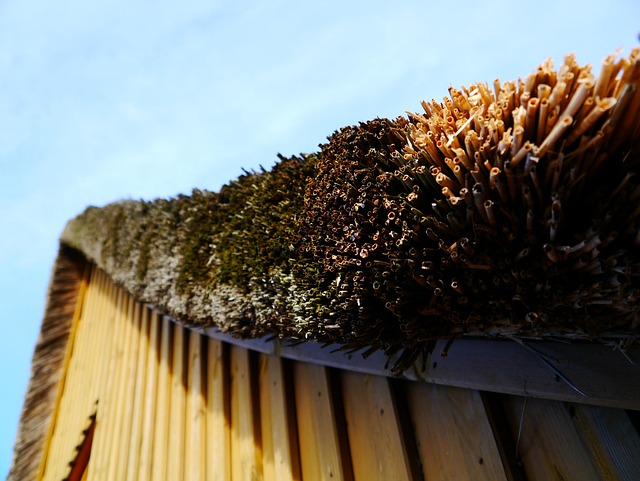Traditional slate roofing, though aesthetically pleasing, is costly, labor-intensive, and prone to damage. As a result, rubber roofing has emerged as a versatile alternative offering superior water resistance, flexibility, and durability. Rubber roofs withstand extreme weather, maintain aesthetic appeal, seal complex rooflines tightly, and require minimal maintenance. They provide long-term protection against cracks and leaks, adapting to building movement. Compared to slate roofing options, rubber roofing is a cost-effective, reliable choice for homeowners seeking durable, low-maintenance solutions.
In search of a robust, flexible roofing solution that offers superior water resistance? Traditional slate roofings, while aesthetically pleasing, present limitations in terms of flexibility and longevity. This article explores an innovative alternative: rubber roofing. We delve into its benefits, from unparalleled water resistance to ease of installation and extended lifespan. Discover why rubber roofing is a practical and durable choice among various slate roofing options.
Understanding Traditional Slate Roofings and Their Limitations
Traditional slate roofing has long been a popular choice for its timeless aesthetic and durability. However, it comes with certain limitations that can make it less than ideal for all situations. One significant drawback is the cost; slate shingles are often expensive due to the natural sourcing and labor-intensive installation process. Moreover, slate roofs are heavy, requiring robust structural support, which can add considerable expense to the overall project.
The weight and fragility of slate also present challenges during installation and maintenance. Slates must be carefully laid and secured, making repairs more complicated and time-consuming. In areas with extreme weather conditions, such as heavy rain or snow, traditional slate roofs may struggle to provide adequate water resistance, potentially leading to leaks and structural damage over time. These limitations have prompted the development of alternative roofing options, like rubber roofing, which offers flexibility, durability, and superior water resistance.
Introducing Rubber Roofing: A Flexible and Durable Alternative
Rubber roofing is a game-changer in the world of roofing materials, offering a flexible and durable alternative to traditional slate roofing options. This innovative choice has gained popularity due to its exceptional water resistance and adaptability, making it a reliable solution for various architectural styles. Unlike slate, which can be brittle and heavy, rubber roofing is designed to withstand extreme weather conditions without compromising on aesthetics.
With its supple nature, rubber roofing provides superior flexibility, ensuring that it conforms to the shape of any roof structure. This property not only makes installation easier but also allows for better sealing around complex rooflines, eliminating common gaps and cracks found in traditional roofs. Moreover, rubber’s natural resistance to moisture, stains, and fading ensures a long-lasting, vibrant finish, contributing to the overall durability and low maintenance requirements.
The Benefits of Rubber Roofing for Water Resistance
Rubber roofing offers exceptional water resistance, making it a superior choice for any property owner seeking reliable protection against the elements. Unlike traditional slate roofing options that may crack or become damaged during extreme weather conditions, rubber roofs are highly flexible and durable. This flexibility allows them to expand and contract with temperature changes, preventing cracks and seals from breaking. As a result, water cannot penetrate the roof’s surface, ensuring your home stays dry and secure.
Moreover, rubber roofing is known for its longevity and low maintenance requirements. The material is resistant to corrosion, decay, and UV damage, which commonly affect other types of roofs. This durability translates into cost savings for homeowners as they won’t need to frequently replace or repair their roofing systems. With its water-repellent properties and robust construction, rubber roofing provides peace of mind, knowing your home is shielded from potential water damage.
Installation Process: How to Achieve a Secure Seal
The installation process for rubber roofing is designed to achieve a secure seal, ensuring optimal flexibility and water resistance. Unlike traditional slate roofing options that require intricate nailing or screeding techniques, rubber shingles are typically installed using a more straightforward method. First, a robust underlayment is laid down to provide insulation and prevent moisture penetration. Then, the rubber shingles are carefully arranged and secured with specialized adhesive or mechanical fasteners. This approach not only simplifies the installation but also allows for easier reparation or replacement of individual shingles if necessary.
Achieving a secure seal involves meticulous alignment and sealing of the joints between each shingle. Contractors often use special mastic or sealant to reinforce these connections, ensuring water cannot seep into the gaps. This step is crucial as it directly impacts the roof’s overall performance, especially in regions with frequent rainfall or snowmelt. The seamless integration of rubber roofing materials creates a flexible barrier that moves with the building, preventing cracks and leaks over time.
Longevity and Maintenance: Ensuring Optimal Performance Over Time
Rubber roofing, known for its flexibility and water resistance, offers a durable solution that can stand the test of time. Unlike traditional slate roofing options, which may require frequent repairs and replacement due to breakage or weather damage, rubber roofs are designed to withstand harsh environmental conditions. They remain intact during storms, strong winds, and extreme temperatures, ensuring your home remains protected.
Proper maintenance is still crucial for optimal performance. Regular inspections help identify potential issues early on, such as loose or damaged shingles. Simple upkeep like cleaning gutters and removing debris prevents water buildup, which could lead to leaks. With the right care, rubber roofing can provide reliable protection for years, proving its longevity and making it a smart investment for any property owner considering slate roofing alternatives.
Rubber roofing emerges as a game-changer in the realm of slate roofing options, offering unparalleled flexibility and water resistance. By understanding the limitations of traditional slate roofing and embracing the benefits of rubber’s durability, homeowners can ensure their roofs stand the test of time. The installation process, though meticulous, provides a secure seal, while regular maintenance guarantees optimal performance. With its longevity and adaptability, rubber roofing is a smart choice for modern homes seeking both style and functionality.
